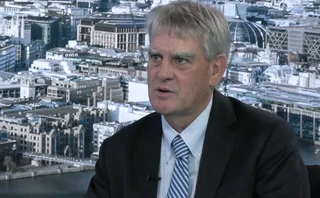
Fixed-income trading platform of the year: UBS
Firm prices saw 'real end-users' flock to Bond Port in 2015

Risk Awards 2016
UBS was not the first global dealer to restructure its business model in the wake of the financial crisis but, arguably, it took the most radical steps. In 2012, the Swiss bank announced it was retreating from capital- and balance sheet-intensive businesses, and would be growing its agency volumes in fixed-income and derivatives markets.
One early manifestation of this strategy was the bank's Price Improvement Network (Pin) for fixed-income products, which allows corporate bond investors to trade directly with one another without having to pay a bid/offer spread to a dealer.
In the four years since its launch, the platform – now renamed UBS Bond Port – has gone from strength to strength, and 2015 was a particularly big year. In the third quarter, the venue racked up $7.7 billion in traded volumes, almost doubling year-on-year, while the number of clients posting prices grew to 465, compared to 299 a year earlier.
The average ticket size on the platform increased from $105,200 to $124,700, and 921 tickets with a value greater than $1 million were processed through Bond Port in the third quarter – a more than three-fold increase compared with the same period of 2014.
Today, indications of interest to either buy or sell bonds are collected from 2,400 different liquidity venues and transmitted through the Bond Port network to 12,000 clients, of which more than 800 unique users are actively trading on the platform each month.
Of the 438 clients leaving liquidity on the platform in the third quarter, only a handful of those were banks, with the rest of the prices provided by real end-user accounts
Mark Russell, UBS
"For asset managers that have always lived in a request-for-quote universe, where they simply take prices from the dealers, the platform allows the buy-side community to become price makers and hence trade against the prices of other buy-side investors," says Mark Russell, global head of fund execution services at UBS in London.
"There were 245,000 total trades executed on Bond Port in 2015, and it is important to note the type of clients trading. Of the 438 clients leaving liquidity on the platform in the third quarter, only a handful of those were banks, with the rest of the prices provided by real end-user accounts," he adds.
Bond Port's main competition comes from alternative trading systems (ATS) such as Bloomberg's ALLQ or New York-based MarketAxess. Both are predominantly traditional dealer-to-client bond-trading platforms, and although non-dealer credit liquidity can be found on MarketAxess, the vast majority of trades are transacted between a dealer market-maker and an end-user liquidity taker.
Bond Port has differentiated itself by creating a network for direct end-user bond trading, and while dealer prices are still on the platform they compete as part of a bigger universe of buy-side prices.
"The traditional method has been to go to an ATS, where clients pay a bid/offer spread based on the dealer price, but the problem has always been that access to other liquidity is somewhat limited. What we have built with Bond Port is a distribution mechanism that allows clients to find each other globally, whether they are holding bonds or looking for bonds. I think that capability is the reason we have doubled trade volumes in the past year and our average ticket size has increased by 20%," says Nicolas Masso (pictured below), head of credit execution services for the Americas at UBS in New York.

While this network is undoubtedly a key attraction for end-users, the biggest distinguishing factor for many Bond Port devotees is a startlingly simple one: UBS requires all users leaving liquidity on the platform to provide firm rather than indicative prices. This might not sound a huge draw, but bond investors say their biggest frustration when trading corporate credit is the lack of firm prices on conventional ATS screens.
"One of our major trading venues is Bond Port and I would say it has no real competition. When you go to other venues there are a lot of unreliable prices from the banks that you can't trust. Those banks simply will not stand behind the prices they quote. It's a disaster out there in the market, it really is. The big difference with UBS is that when you see a price on Bond Port you know you can trade it. That is the single-biggest advantage of trading there," says a bond trader at a European private bank.
One of our major trading venues is Bond Port and I would say it has no real competition
Nicolas Masso, UBS
The insistence on firm prices runs against typical practice for credit market-makers. Cynical buy-siders claim dealers use indicative prices as a way to draw clients into a negotiation over the bid/offer. In contrast, non-bank counterparties actively seeking to acquire or dispose of bond inventory can be more comfortable setting a hard price at which they will agree to buy or sell paper. Banks who want to trade on the platform have to play by the same rules.
"If by advertising an indicative price a bank can get clients to come in and engage in a real discussion about the price of a bond, what is the incentive for the traditional players to change? What we are doing with Bond Port is disrupting that model because we have heard from clients they don't like non-firm prices. We have a network with the potential to pool prices from 2,400 sources, and if the dealers wish to step into this distribution network they need to give us firm prices," says Russell.
Only users who have a paid subscription or are part of a corporate subscription are able to print or copy content.
To access these options, along with all other subscription benefits, please contact info@risk.net or view our subscription options here: http://subscriptions.risk.net/subscribe
You are currently unable to print this content. Please contact info@risk.net to find out more.
You are currently unable to copy this content. Please contact info@risk.net to find out more.
Copyright Infopro Digital Limited. All rights reserved.
As outlined in our terms and conditions, https://www.infopro-digital.com/terms-and-conditions/subscriptions/ (point 2.4), printing is limited to a single copy.
If you would like to purchase additional rights please email info@risk.net
Copyright Infopro Digital Limited. All rights reserved.
You may share this content using our article tools. As outlined in our terms and conditions, https://www.infopro-digital.com/terms-and-conditions/subscriptions/ (clause 2.4), an Authorised User may only make one copy of the materials for their own personal use. You must also comply with the restrictions in clause 2.5.
If you would like to purchase additional rights please email info@risk.net
More on Awards
Collateral management and optimisation product of the year: CloudMargin
Delivering the modern blueprint for enterprise collateral resilience
Flow market-maker of the year: Citadel Securities
Risk Awards 2026: No financing; no long-dated swaps? “No distractions,” says Esposito
Pricing and analytics: fixed income – Quantifi
Quantifi delivers high-performance, transparent and adaptable pricing and risk analytics for fixed income and credit markets
Derivatives house of the year: Citi
Risk Awards 2026: Rev up, RWAs down, as US bank gets back on track (with added XiNG and XiP)
Technology vendor of the year: SS&C Algorithmics
Risk Awards 2026: From cloud, to chips, to maths tricks – vendor getting more out of existing tech
SS&C Algorithmics: winner’s interview with Curt Burmeister
SS&C Algorithmics wins three categories in this year’s Markets Technology Awards in addition to Technology vendor of the year at the Risk Awards
Best vendor for system support and implementation: Murex
Murex wins Best vendor for system support and implementation at the Markets Technology Awards 2026
Pricing and analytics: cross-asset and structured – Murex
Murex wins Pricing and analytics: cross-asset and structured at the Markets Technology Awards 2026 thanks to its MX.3 platform







